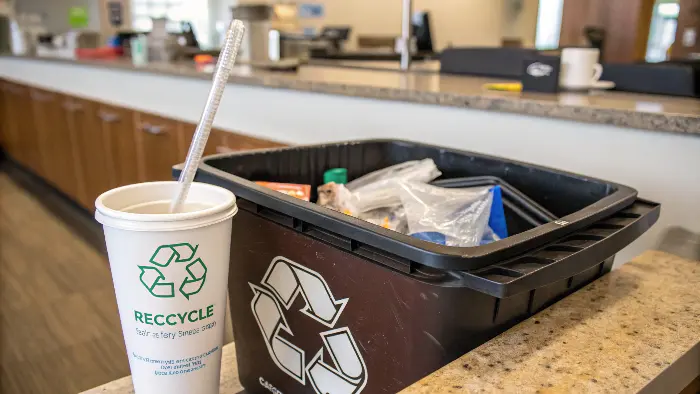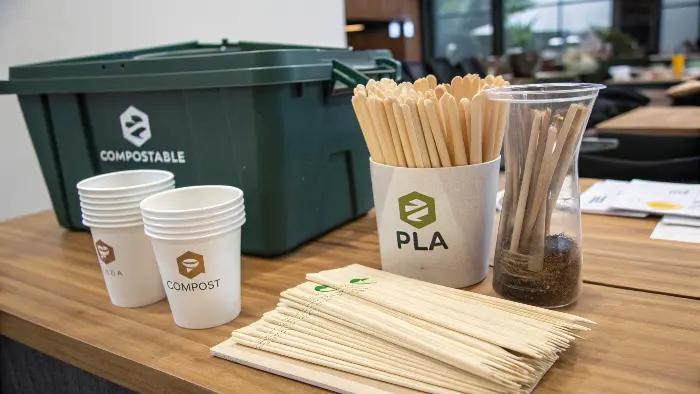Sipping coffee but feeling guilty about that tiny stirrer? Those little sticks add up to big waste. Let’s find a truly eco-friendly way to mix your brew.
Biodegradable stirrers, especially wood or bamboo, are much kinder to our planet than plastic ones. They break down way faster, reducing long-term pollution and our reliance on fossil fuels. It’s a small switch with a surprisingly big impact!
It’s funny how something so small, like a coffee stirrer, can get you thinking, right? I mean, you use it for what, ten seconds? And then it’s tossed. But multiply that by millions of coffee drinkers every day, and suddenly it’s a mountain of waste. This is something we talk about a lot at Ecosourcecn, especially with clients like Jacky in Canada, who are always looking for genuinely sustainable solutions. It’s not just about looking green; it’s about being green. So, let’s stir things up and get to the bottom of this!
What are coffee stirrers made of?
Ever wonder what that little stick swirling your morning coffee is actually made from? It seems simple, but the material massively impacts its eco-friendliness. Let’s take a closer look at the common culprits and the better alternatives.
Coffee stirrers are commonly made from either plastic (usually polystyrene or polypropylene) or biodegradable materials like wood (birch is popular), bamboo, or even bioplastics like PLA (polylactic acid) derived from plant starches.
When I first started digging into sustainable sourcing, the sheer variety of materials for everyday items like stirrers was surprising. You pick one up, use it, and don’t give it a second thought. But as a business, and as consumers, understanding these materials is key. It’s the difference between contributing to a problem or being part of the solution. This is a core part of our mission at Ecosourcecn – helping businesses make informed, eco-conscious choices.
The Usual Suspect: Plastic Stirrers
Let’s be honest, plastic stirrers are everywhere. They’re cheap to produce, lightweight, and get the job done. The most common types you’ll encounter are:
- Polystyrene (PS #6): This is a big one. It’s rigid, cheap, but also a real pain environmentally. Think of those brittle plastic stirrers that snap easily. It’s not widely recycled, especially in small forms like stirrers, and can leach styrene, which isn’t great.
- Polypropylene (PP #5): Sometimes used for more flexible or robust stirrers. While PP is technically recyclable, again, the small size and contamination make stirrers a nightmare for recycling facilities.
The main issue with these plastic options is their origin – fossil fuels – and their end-of-life. They stick around for hundreds, if not thousands, of years, breaking down into microplastics. I remember seeing a beach littered with tiny plastic fragments, stirrers included, and it was just heartbreaking. That image really stuck with me.The Greener Alternatives: Biodegradable Stirrers
Thankfully, there are much better options out there, and these are what we champion!
- Wood: This is probably my favorite. Stirrers made from birchwood or other sustainable woods are fantastic. They are strong, have a nice feel, and, most importantly, are biodegradable and compostable. We often source FSC-certified wooden stirrers for clients, ensuring they come from responsibly managed forests. They break down naturally, returning to the earth. How cool is that?
- Bamboo: Another excellent natural material. Bamboo is a fast-growing grass, super sustainable, and strong. Bamboo stirrers offer similar benefits to wood – biodegradable, compostable, and a great mouthfeel.
- PLA (Polylactic Acid): This is a type of bioplastic made from plant starches (like corn or sugarcane). PLA stirrers look and feel like plastic but are designed to be compostable in industrial facilities. They need specific conditions (heat, moisture, microbes) to break down properly, which is an important distinction.
Understanding these material differences is the first step. It’s not just a stirrer; it’s a choice.Are plastic coffee stirrers recyclable?
You toss that tiny plastic stirrer into the recycling bin, feeling good, right? But hold on – are you sure it actually gets recycled? The truth about recycling these little plastic pieces might surprise you, and frankly, it’s a bit disappointing.
No, generally plastic coffee stirrers are NOT recyclable in most municipal recycling programs. Their small size and the type of plastic they’re often made from (like polystyrene) make them contaminants in the recycling stream.

This is a classic case of what I call "wishcycling." We want it to be recyclable, we hope it is, so we toss it in the blue bin. I used to do it too, before I really dove into how material recovery facilities (MRFs) work. It’s a common misconception, and one we often have to clarify for businesses looking to make genuinely eco-friendly choices. The reality is, these little guys cause more problems than they solve in a recycling plant.
Why Your Plastic Stirrer Likely Ends Up in Landfill
There are a few solid reasons why those plastic stirrers don’t make the recycling cut:
- Size Matters (A Lot!): Most MRFs use automated sorting equipment, like screens and optical sorters. Tiny items like stirrers, bottle caps (if not on the bottle), and straws literally fall through the cracks or get mis-sorted. They are too small for the machinery to handle effectively. I’ve seen videos of these facilities – it’s fascinating but also highlights how easily small plastics are missed.
- Material Type: Many plastic stirrers are made from Polystyrene (#6 plastic). This type of plastic has very low market demand for recycling, it’s often contaminated, and it’s lightweight but bulky, making it economically unviable to collect and process for many municipalities. Even if it could be recycled, there’s often no one who wants to buy the recycled material. It’s a tough truth.
- Contamination: Coffee stirrers are, by definition, contaminated with coffee, sugar, cream, etc. Food contamination is a huge issue in recycling. Items need to be relatively clean to be processed properly. A sticky, sugary stirrer is a recycling facility’s nightmare.
The "Mobro 4000" Effect (on a smaller scale)
Remember the Mobro 4000 garbage barge that sailed around for months looking for a place to dump its load? While not as dramatic, rejected bales of mixed plastics often happen because of contamination and non-recyclable items mixed in. Each little stirrer contributes to this bigger problem of degrading the quality of recyclable plastics.
So, what happens to them? They usually end up being sifted out and sent to landfill or incineration, along with other non-recyclable waste. This is why, when we advise clients at Ecosourcecn, we stress that choosing materials that are truly circular (like properly compostable wood) or easily recyclable in their intended form is so much better than relying on the often-flawed plastic recycling system for tiny items. It’s about designing waste out from the beginning.Are coffee stirrers compostable?
So, you’ve opted for a non-plastic stirrer – good move! But now the question is, can you just toss it in your compost bin? The answer is a hopeful "mostly yes," but with some important details to stir in. Let’s get to the bottom of it.
Yes, many non-plastic coffee stirrers, especially those made from untreated wood or bamboo, are compostable. PLA (bioplastic) stirrers are also compostable, but usually only in industrial composting facilities, not typically in home compost heaps.

This is where things get exciting for me! At Ecosourcecn, we’re big believers in composting as a circular solution for organic waste and suitable packaging. When Jacky from Canada asks us about end-of-life for products like stirrers, "compostable" is a word we love to hear, but we always make sure to clarify the type of compostability. It’s not always a one-size-fits-all scenario, and that’s super important for consumers and businesses to understand.
The Breakdown on Different Stirrer Materials:
Let’s look at how different materials fare in a compost environment:
- Wooden Stirrers:
- Home Compostable? Generally, yes! Untreated wooden stirrers (like plain birchwood) will break down beautifully in a well-managed home compost bin. They’re just small pieces of organic material. Think of them like small twigs. I toss mine in my backyard compost all the time, and they disappear within a few months.
- Industrially Compostable? Absolutely. They break down even faster in the hotter, more controlled environment of an industrial facility.
- Bamboo Stirrers:
- Home Compostable? Yes, similar to wood, bamboo stirrers will decompose in a home compost. Bamboo is a natural fiber and breaks down well.
- Industrially Compostable? Yes, no problem here either.
- PLA (Polylactic Acid) Stirrers:
- Home Compostable? Usually no. PLA requires higher temperatures (typically 55-70°C or 130-160°F) and specific microbes found in industrial composting facilities to break down effectively within a reasonable timeframe. They’ll just sit there in a cool home compost pile for a very, very long time.
- Industrially Compostable? Yes! This is what they are designed for. Look for certifications like BPI (Biodegradable Products Institute) in North America or EN 13432 in Europe. These certifications ensure the product will break down as claimed in a commercial setting.
Why Certifications Matter (Especially for Jacky!)
For someone like Jacky, who is sourcing products for a brand, certifications are crucial. They provide third-party verification that a product meets specific compostability standards. Certification Standard What it Means Key Region BPI Certified Meets ASTM D6400 or D6868 standards for industrial compostability in the US. North America EN 13432 European standard for industrial compostability (disintegration, biodegradation, eco-toxicity). Europe TÜV AUSTRIA OK compost HOME Certifies products as compostable in home/garden compost environments. International When we supply PLA products, ensuring they have the right certifications for the client’s market is a top priority. It’s about transparency and ensuring the products perform as expected environmentally. It’s a detail that makes a big difference in credibility and genuine sustainability. So, if you see PLA, check for that industrial composting info! For wood and bamboo, you’re generally good to go for home composting – which is a fantastic, simple win!
Conclusion
Choose wood or bamboo stirrers for a truly eco-friendly coffee. They break down naturally, unlike plastic, making your daily caffeine fix a little kinder to our Earth.


